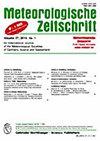沿海对海上风力发电场的影响——以德国海湾地区为重点的综述
IF 1.2
4区 地球科学
Q4 METEOROLOGY & ATMOSPHERIC SCIENCES
引用次数: 5
摘要
大气边界层在沿海地区经历了多重变化,特别是风向由陆向海,由于海洋表面粗糙度较小,风速通常会增加。这些影响与海上风能利用特别相关;它们被归纳为海岸效应一词。本文概述了海岸效应及其对海上风电场运行条件的潜在影响,重点是德国湾。介绍了研究海岸效应和内边界层发展的常用数值和实验工具,并对研究现状进行了综述。德国湾是一个有趣的例子,说明了沿海效应对海上风能的影响,因为大量的风力涡轮机与海岸距离为100公里或更短。讨论了与边界层稳定性有关的现象,如低空射流。分析了瓦登海不同水深下海岸带垂直热通量的空间变化规律。该研究表明,由于海上风电场的规模不断扩大,由海岸效应引起的水平风速梯度可能导致单个风电场内的显著风力变化。在风力机轮毂高度和转子直径不断增加,风电场规模不断扩大的背景下,在风能领域快速发展的背景下,讨论了需要进一步关注的研究课题。一个例子是海岸效应与海上风电场尾流的相互作用。强调了考虑大范围的空间和时间尺度来理解和描述海岸效应的必要性。总结了适用于沿海地区边界层动力学调查和预报的模拟和观测工具。结合x -尾流项目中几个实例的观测和模型结果,介绍了现有的应用和结果。这项研究特别强调不同的测量和模拟技术相结合所提供的巨大潜力,并就今后发展综合办法,包括拟订优先事项提出建议。本文章由计算机程序翻译,如有差异,请以英文原文为准。
Coastal impacts on offshore wind farms – a review focussing on the German Bight area
The atmospheric boundary layer experiences multiple changes in coastal regions, especially with wind directions from land towards the sea, where the wind speed usually increases due to the smaller roughness of the ocean surface. These effects are of particular relevance for offshore wind energy utilization; they are summarized under the term coastal effects. This paper provides an overview of coastal effects and their potential impact on the operating conditions of offshore wind farms with a focus on the German Bight. Common numerical and experimental tools to study coastal effects and developing internal boundary layers (IBL) are introduced, and a review on the current state of research is given. The German Bight is an interesting example to illustrate impacts of coastal effects on offshore wind energy, because of the large number of wind turbines with a coastal distance of 100 km or less. Phenomena related to the stability of the boundary layer, like low level jets, are discussed. Spatial variations of vertical heat fluxes in the coastal zone related to variable water depths or Wadden Sea areas are analysed. The study illustrates that due to the increasing size of offshore wind farms, horizontal wind speed gradients caused by coastal effects can lead to significant wind variations within a single farm. Research topics which still need further attention are discussed in the framework of the rapidly developing wind energy sector with increasing wind turbine hub heights and rotor diameters as well as growing wind farm sizes. One example is the interaction of coastal effects with offshore wind farm wakes. The necessity to consider a large spectrum of spatial and temporal scales to understand and describe coastal effects is highlighted. We summarize modelling and observation tools, which are suitable for the investigation and prediction of the boundary layer dynamics in coastal areas. Existing applications and results are described based on several examples with collocated observation and model results obtained in the X-Wakes project. The study puts particular focus on the large potential provided by the combination of different measurements and modelling techniques and gives recommendations for future developments of integrated approaches including the formulation of priorities.
求助全文
通过发布文献求助,成功后即可免费获取论文全文。
去求助
来源期刊

Meteorologische Zeitschrift
地学-气象与大气科学
CiteScore
2.80
自引率
8.30%
发文量
19
审稿时长
6-12 weeks
期刊介绍:
Meteorologische Zeitschrift (Contributions to Atmospheric Sciences) accepts high-quality, English language, double peer-reviewed manuscripts on all aspects of observational, theoretical and computational research on the entire field of meteorology and atmospheric physics, including climatology. Manuscripts from applied sectors such as, e.g., Environmental Meteorology or Energy Meteorology are particularly welcome.
Meteorologische Zeitschrift (Contributions to Atmospheric Sciences) represents a natural forum for the meteorological community of Central Europe and worldwide.
 求助内容:
求助内容: 应助结果提醒方式:
应助结果提醒方式:


